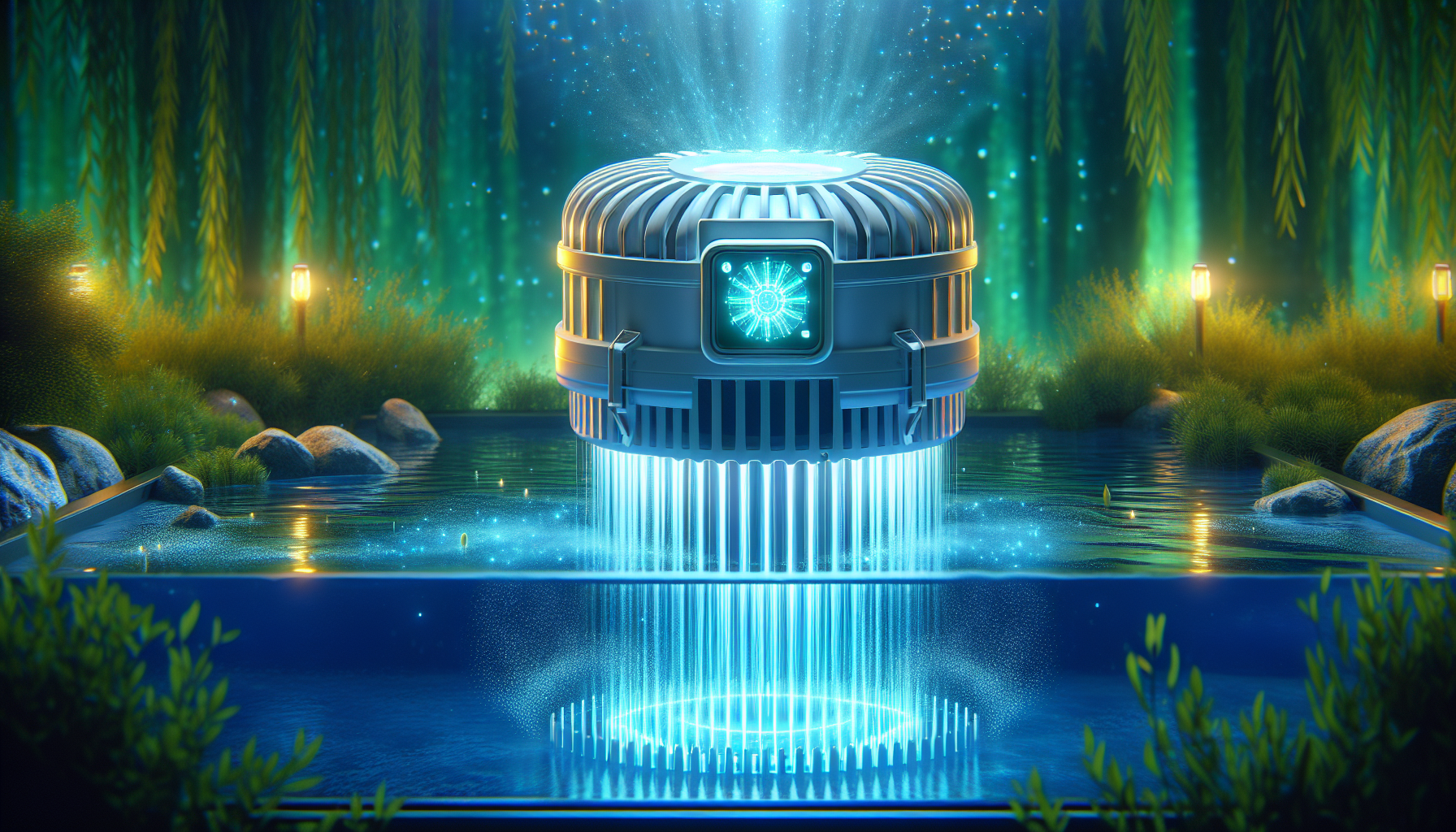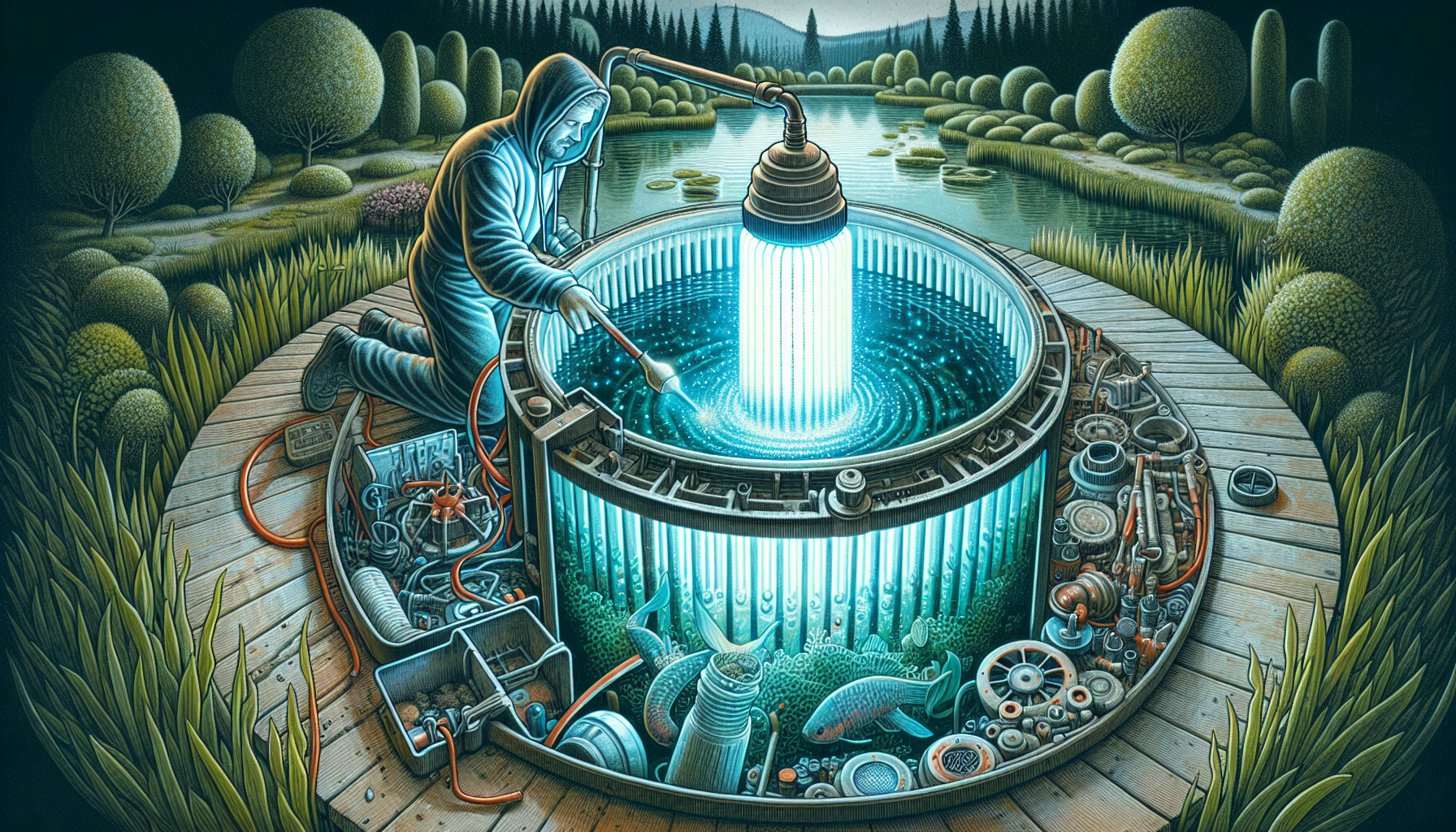Crystal Clear Waters: Choose the Best UV Pond Clarifier for Algae-Free Ponds
If you’re tired of murky pond water, mastering the use of a UV pond clarifier might just be your next move. This no-nonsense guide helps you select, install, and maintain the ideal clarifier to combat algae, ensuring clean water year-round. Skip the trial and error and dive straight into clear pond management.
Key Takeaways
-
UV clarifiers combat green water in ponds by emitting ultraviolet light that neutralizes single-celled algae, regulating algae growth without creating a sterile environment or harming the balanced ecosystem.
-
Choosing the correct UV clarifier depends on the pond’s size and water flow rate, with a general guideline of 10 Watts per 1000 gallons, and it’s important to match the clarifier to the pump’s capacity for optimal effectiveness.
-
Effective maintenance of UV clarifiers includes careful installation, regular cleaning, bulb replacement approximately every 11 months, and seasonal adjustments for year-round use, considering overall cost, including operational expenses and the potential long-term savings of higher-quality units.
Understanding UV Clarifiers and How They Work

At the heart of every UV clarifier lies a UV bulb, the unsung hero in the battle against green water. This bulb emits ultraviolet light, a powerful force capable of neutralizing single-celled algae by dismantling their DNA, without the need for chemicals. This process prevents the algae from reproducing, eventually leading to clear water.
However, don’t misconstrue this as an indiscriminate attack on all microorganisms. The UV clarifier cleverly operates at a reduced UV strength per volume, regulating rather than eradicating green water. This distinction between a UV clarifier and a sterilizer is crucial, as the aim is not to create a sterile environment, but a balanced ecosystem.
UV clarifiers work tirelessly to maintain this balance, ensuring that your small ponds remain a haven of tranquility. And the best part? The entire process is invisible to the naked eye. So while you sit back and enjoy the clear water, the pond clarifier, also known as a UV clarifier, is working its magic behind the scenes.
If the unending battle against green water exhausts you, a UV clarifier could be your answer. But, choosing the right one for your pond can be challenging. We’ll explore that in the following section.
Selecting the Right Size and Power for Your Pond
The selection of a UV clarifier largely depends on the size of your pond. Your pond’s capacity in gallons is vital information as it helps you determine the requisite UV power. Generally, you’ll want around 10 Watts per 1000 gallons for effective green water control.
But it’s not just about the size of your pond, it’s also about how quickly the water passes through the clarifier. Ideally, all pond water should pass through the clarifier within an hour, especially in fish ponds. This ensures that the UV light has enough time to do its job effectively. It’s also important to consider how a new clarifier will impact the existing flow rate.
What if you plan to expand your pond in the future? Well, it might be worth selecting a UV clarifier with a higher wattage than immediately necessary. This way, you’re future-proofing your setup, avoiding the need for a replacement unit down the line.
Lastly, don’t overlook the pump’s critical role in facilitating water flow. The chosen pump should adequately handle both your pond’s volume and the UV clarifier’s requirements.
Installation and Maintenance Tips
To achieve optimal results, the positioning of your UV clarifier is of significant importance. A location after the biological filtration system would be ideal. This positioning protects the unit’s quartz tube from debris, ensuring a smooth and efficient operation.
When deciding where to install your clarifier, choose a dry, flat surface that’s protected from flooding. For example, a canister pond filter lid would be an ideal location. You’ll also want to ensure that the UV clarifier’s flow rate matches the pond’s volume to move half the pond’s volume through the clarifier every hour.
UV bulbs and sleeves are delicate components, so handle with care. To prevent overheating and extend bulb life, avoid touching UV bulbs with bare hands and clean any fingerprints with a cloth. You should also regularly check if the UV light is operational through the opaque window on the clarifier’s housing.
Maintenance is key for the longevity of your UV clarifier. Regularly disconnect, drain, and clean it, ensuring it can run continuously during the water gardening season. And don’t forget to incorporate additional filtration to remove debris from the pond water, as the UV clarifier only neutralizes the microorganisms.
Cost Considerations: Price vs. Quality
The cost of UV pond clarifiers can fluctuate widely, with prices ranging anywhere from $150 to beyond $500. This initial cost is influenced by several factors including:
-
The unit’s wattage
-
Size capacity
-
Installation expenses
-
The need for replacement bulbs
While it might be tempting to go for the cheapest option, it’s important to consider the long-term operational costs. For instance, maintaining a UV pond filter for a 1000-gallon pond, including electricity and bulb replacement, can cost around $175 annually.
Therefore, before finalizing your purchase, it would be wise to weigh the affordability against the operational costs. It’s crucial to remember that a higher initial investment could result in a more cost-effective solution in the long run, especially when you factor in the quality and longevity of the product.
Seasonal Care for Your UV Clarifier

Just like other outdoor accessories, your UV clarifier will need care tailored to each season. The usage should be adjusted based on the seasonal temperatures and sun exposure, with more usage required during higher temperatures due to increased algae growth.
In milder climates, a UV clarifier can be used year-round without the need for winterizing. However, it’s important to remember that UV bulbs should be replaced every two seasons, or approximately every eleven months, to maintain effectiveness. Even if the light seems to be functioning, the effectiveness can wane over time, so keeping a maintenance record for bulb replacement is advisable.
As for the colder months, it’s prudent to shield your UV clarifier from potential frost damage by draining and storing it indoors during winter. This will ensure your unit is ready to go when the warmer weather returns.
Environmental Impact and Safety
Despite their effectiveness in eliminating algae and bacteria, UV pond clarifiers could potentially disturb the natural ecosystem. This disruption could result in an imbalance in the biological cycle due to their impact on beneficial microorganisms. Moreover, long-term reliance on UV pond clarifiers could result in an increase of harmful gram-negative bacteria when the device is turned off.
UV clarifiers should always be connected to a Ground Fault Interrupter (GFI) outlet for safety to prevent electrical shock. Additionally, it’s important to remember that exposure to UV light from the bulbs can be harmful. Therefore, never look directly at an unshielded bulb. Inspections should be performed through an opaque window on the device housing.
Lastly, it’s worth noting that the sterilizing effect of UV clarifiers can render certain fish medications ineffective. So, during fish treatment periods, you’ll need to deactivate the UV system to ensure the medication works as intended.
Summary
We’ve journeyed through the world of UV pond clarifiers, exploring their functionality and understanding how they can be a powerful tool in maintaining clear, green-free ponds. From selecting the right size and power for your pond, to installation and maintenance tips, cost considerations, and seasonal care - we’ve covered it all.
But remember, while UV clarifiers are an effective solution, it’s important to consider their potential environmental impact and the necessary safety measures. By doing so, you’ll not only enjoy a beautiful, clear pond but also contribute to a balanced and safe ecosystem. After all, isn’t that the ultimate goal of every nature enthusiast?
Frequently Asked Questions
How often should I replace the UV bulb in my pond clarifier?
You should replace the UV bulb in your pond clarifier every two seasons, or approximately every eleven months, to ensure it remains effective.
Can I use my UV clarifier year-round?
Yes, you can use your UV clarifier year-round in milder climates without requiring winterizing.
What is the difference between a UV clarifier and a sterilizer?
The main difference between a UV clarifier and a sterilizer is that a UV clarifier operates at a lower UV strength per volume to control rather than eliminate green water, maintaining a balanced ecosystem.
How much does a UV pond clarifier cost?
UV pond clarifiers can cost anywhere from $150 to over $500, depending on their wattage, size capacity, and other factors.
What are the safety considerations when using a UV clarifier?
When using a UV clarifier, it's crucial to connect it to a Ground Fault Interrupter (GFI) outlet to prevent electrical shock. Additionally, avoid looking directly at an unshielded bulb to protect your eyes.





















